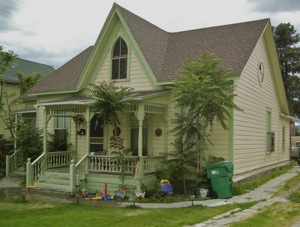Loading up the car in San Mateo, it was cool and cloudy. We drove through the usual insane Bay area morning traffic, up through Berkeley and Richmond, and began climbing up through the Coastal Range. The clouds grew thinner and thinner, until by the time we reached Concord, we were driving under a cloudless sky. The hills were a crisp golden brown.
We descended out of the Coastal Range onto the flat plain of the Central Valley. Carol saw a sign: Local Cherries, Take Dixon Exit. We took the exit and bought cherries, apricots, plums, and some tree nuts at Dixon Fruit Stand. I was trying to figure out the ethnicity of the woman who waited on us when I saw a newspaper clipping on the wall, telling how a family escaped from Iran and bought out the venerable Dixon Fruit Stand.
We ran into cloud cover again he Sierra Nevadas, and a few sprinkles of rain. We stopped at a MacDonalds fast food joint, mostly to use the bathroom. The french fries had been cooked in stale oil that tasted of hash browns, onion rings, and other things we couldn’t put a name to. There was still some snow on the high peaks in the Sierras, and the driving was, as usual, unpleasant, as cars tried to dodge around big trucks that ground slowly up the steep grades.
We stopped in downtown Reno at 4 p.m. for a cheap meal. We took a walk and came across a tiny residential neighborhood in the shadow of one of the big casinos. One house was particularly attractive. We stopped to admire it, and a good-looking pug dog came out to challenge us. “Don’t worry about him, he’s harmless,” said the man sitting on the porch. Carol asked if she could pet him, and the man said it would be fine. We asked him about his house.

House on Ralston St., Reno, between 3rd and 4th Ave.
The man said his house was one of the older houses in Reno. “This walking tour came around, and they said the house was completed in September of 1876,” he said. “It’s one of the seven oldest houses left in Reno.” A young man walked up carrying a fishing rod, and the pug dog started barking frantically at him. “Stop it, Chuckles,” said the man. We stopped and talked for a while longer, and I asked for permission to photograph the house. “Sure,” he said, “and I’ll get out of the picture so it looks good.”
The cloud cover continued as we drove through the high desert of the Great Basin, and a few spatters of rain hit the windshield. The sage brush was as green as I have ever seen it, and the whole landscape looked fresh and alive — by desert standards, anyway. We were driving through the Forty Mile Desert, and we saw pools of standing water in among the stands of rushes, and the patches of white alkali dust.
Mark Twain crossed the Forty Mile Desert by stage coach in 1861, and he described his crossing: ” On the nineteenth day we crossed the Great American Desert–forty memorable miles of bottomless sand, into which the coach wheels sunk from six inches to a foot. We worked our passage most of the way across. That is to say, we got out and walked. It was a dreary pull and a long and thirsty one, for we had no water. From one extremity of this desert to the other, the road was white with the bones of oxen and horses. It would hardly be an exaggeration to say that we could have walked the forty miles and set our feet on a bone at every step! The desert was one prodigious graveyard. And the log-chains, wagon tyres, and rotting wrecks of vehicles were almost as thick as the bones. I think we saw log-chains enough rusting there in the desert, to reach across any State in the Union. Do not these relics suggest something of an idea of the fearful suffering and privation the early emigrants to California endured?”
A half an hour before we got to Winnemucca, our stopping place for the night, we stopped at Thunder Mountain Monument — see the photographs in the subsequent blog post.
